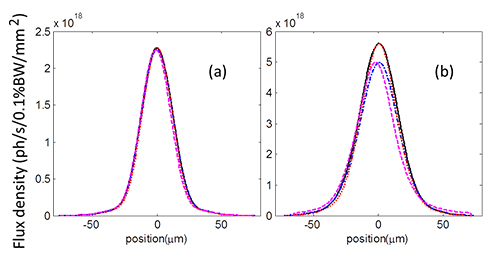X-RAY RUNS: Apply for Beamtime
2017 Nov 1 - Dec 21
2018 Feb 7 - Apr 3
2018 Proposal/BTR deadline: 12/1/17
2018 Apr 11 - Jun 4
2018 Proposal/BTR deadline: 2/1/18
It is well known that delivery of undistorted laser beams requires superior optics. To a much more demanding degree, delivery of highly coherent ERL x-ray beams from source to experiment requires small wavefront distortion over the whole beam. On the other hand, long ERL undulators with short periods will generate higher radiation power density on beamline first optics than encountered at 3rd generation sources. We have recently published thermal and strain analyses, and wavefront simulation for cryogenic cooled Si(111) monochromators showing that beam quality within the radiation central cone should be well preserved. This important result depends strongly on very small ERL source emittance in BOTH horizontal and vertical directions, making the undulator central cone very small. In the end total power accepted by beamline first optics is comparable to that at 3rd generation sources. Taking the 25 m long ERL helical undulator as an example, even at highest possible power density, wavefront simulations for 1:1 focusing show very little change from the results without considering crystal thermal deformation. This implies the beam onto future optics, downstream of the monochromator, is equivalent to that from a source with very small wavefront distortions. Given the fact that wavefront preserving mirrors and other focusing optics are already available for 3rd generation sources, this optics study gives us confidence for the performance of future ERL beamlines.

Wavefront simulation for 1:1 focusing of ERL 25 m helical undulator source at highest possible on-axis power density condition of K = 0.707. Solid and dotted lines represent the horizontal and vertical profiles without considering crystal thermal deformation, and the dash-dotted and dashed lines are the profiles considering crystal deformation. ERL operation corresponds to: 25mAmp high coherence mode in (a), where changes are too small to be noticeable, and even with ERL in 100mAmp high flux mode (b), the profile changes are very moderate.
Link to paper (PDF):
http://iopscience.iop.org/1742-6596/493/1/012035/pdf/1742-6596_493_1_012035.pdf
Submitted by: Rong Huang, CHESS, Cornell University
05/02/2014
